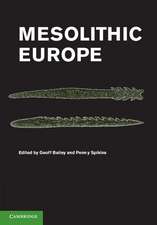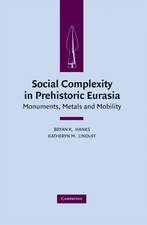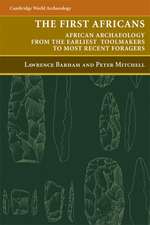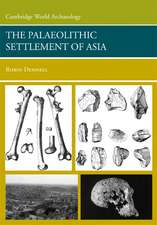Macroevolution in Human Prehistory: Evolutionary Theory and Processual Archaeology
Editat de Anna Prentiss, Ian Kuijt, James C. Chattersen Limba Engleză Hardback – oct 2009
The chapters in the volume examine the dynamic interaction between the micro- and macro-scales of cultural evolution, developing a theoretical approach to the archaeological record that has been termed evolutionary processual archaeology. The contributions in this volume integrate positive elements of both evolutionary and processualist schools of thought. The approach, as explicated by the contributors in this work, offers novel insights into topics that include the emergence, stasis, collapse and extinction of cultural patterns, and development of social inequalities. Consequently, these contributions form a stepping off point for a significant new range of cultural evolutionary studies.
| Toate formatele și edițiile | Preț | Express |
|---|---|---|
| Paperback (1) | 956.33 lei 6-8 săpt. | |
| Springer – 28 noi 2014 | 956.33 lei 6-8 săpt. | |
| Hardback (1) | 952.40 lei 6-8 săpt. | |
| Springer – oct 2009 | 952.40 lei 6-8 săpt. |
Preț: 952.40 lei
Preț vechi: 1161.47 lei
-18% Nou
Puncte Express: 1429
Preț estimativ în valută:
182.24€ • 189.90$ • 150.90£
182.24€ • 189.90$ • 150.90£
Carte tipărită la comandă
Livrare economică 03-17 aprilie
Preluare comenzi: 021 569.72.76
Specificații
ISBN-13: 9781441906816
ISBN-10: 1441906819
Pagini: 336
Ilustrații: IX, 324 p.
Dimensiuni: 155 x 235 x 33 mm
Greutate: 0.64 kg
Ediția:2010
Editura: Springer
Colecția Springer
Locul publicării:New York, NY, United States
ISBN-10: 1441906819
Pagini: 336
Ilustrații: IX, 324 p.
Dimensiuni: 155 x 235 x 33 mm
Greutate: 0.64 kg
Ediția:2010
Editura: Springer
Colecția Springer
Locul publicării:New York, NY, United States
Public țintă
ResearchDescriere
Cultural evolution, much like general evolution, works from the assumption that cultures are descendent from much earlier ancestors. Human culture manifests itself in forms ranging from the small bands of hunters, through intermediate scale complex hunter-gatherers and farmers, to the high density urban settlements and complex polities that characterize much of today’s world.
The chapters in the volume examine the dynamic interaction between the micro- and macro-scales of cultural evolution, developing a theoretical approach to the archaeological record that has been termed evolutionary processual archaeology. The contributions in this volume integrate positive elements of both evolutionary and processualist schools of thought. The approach, as explicated by the contributors in this work, offers novel insights into topics that include the emergence, stasis, collapse and extinction of cultural patterns, and development of social inequalities. Consequently, these contributions form a stepping off point for a significant new range of cultural evolutionary studies.
The chapters in the volume examine the dynamic interaction between the micro- and macro-scales of cultural evolution, developing a theoretical approach to the archaeological record that has been termed evolutionary processual archaeology. The contributions in this volume integrate positive elements of both evolutionary and processualist schools of thought. The approach, as explicated by the contributors in this work, offers novel insights into topics that include the emergence, stasis, collapse and extinction of cultural patterns, and development of social inequalities. Consequently, these contributions form a stepping off point for a significant new range of cultural evolutionary studies.
Cuprins
I. Issues in Macroevolutionary Theory.- Proximate Causation, Group Selection, and the Evolution of Hierarchical Human Societies: System, Process, and Pattern.- Landscape Learning in Relation to Evolutionary Theory.- #x201C;The Multiplication of Forms:#x201D; Bering Strait Harpoon Heads as a Demic and Macroevolutionary Proxy.- II. Macroevolutionary Approaches to Cultural Change.- The Emergence of New Socioeconomic Strategies in the Middle and Late Holocene Pacific Northwest Region of North America.- Testing the Morphogenesist Model of Primary State Formation: The Zapotec Case.- Evolutionary Biology and the Emergence of Agriculture: The Value of Co-opted Models of Evolution in the Study of Culture Change.- III. Cultural Diversification, Stasis and Extinction as Macroevolutionary Processes.- A Macroevolutionary Perspective on the Archaeological Record of North America.- Cultural Stasis and Change in Northern North America: A Macroevolutionary Perspective.- Niche Construction, Macroevolution, and the Late Epipaleolithic of the Near East.- IV. Macroevolutionary Theory in Archaeology.- Macroevolutionary Theory and Archaeology: Is There a Big Picture?.- Material Cultural Macroevolution.
Recenzii
From the reviews:
“This comprehensive volume on macroevolutionary theory is a recent attempt to revitalize evolutionism in archaeology. … The study of … memes facilitates the observation of cultural evolution. … this book is a significant and impressive contribution to evolutionary studies of cultural change, it propagates rhetoric inherent in this rigid perspective on dynamic variables like human behavior and the environment.” (Heather Kendall, The Midden, Vol. 43 (2), 2011)
“This comprehensive volume on macroevolutionary theory is a recent attempt to revitalize evolutionism in archaeology. … The study of … memes facilitates the observation of cultural evolution. … this book is a significant and impressive contribution to evolutionary studies of cultural change, it propagates rhetoric inherent in this rigid perspective on dynamic variables like human behavior and the environment.” (Heather Kendall, The Midden, Vol. 43 (2), 2011)
Textul de pe ultima copertă
Cultural evolution, much like general evolution, works from the assumption that cultures are descendent from much earlier ancestors. Human culture manifests itself in forms ranging from the small bands of hunters, through intermediate scale complex hunter-gatherers and farmers, to the high density urban settlements and complex polities that characterize much of today’s world.
The chapters in the volume examine the dynamic interaction between the micro- and macro-scales of cultural evolution, developing a theoretical approach to the archaeological record that has been termed evolutionary processual archaeology. The contributions in this volume integrate positive elements of both evolutionary and processualist schools of thought. The approach, as explicated by the contributors in this work, offers novel insights into topics that include the emergence, stasis, collapse and extinction of cultural patterns, and development of social inequalities. Consequently, these contributions form a stepping off point for a significant new range of cultural evolutionary studies.
The chapters in the volume examine the dynamic interaction between the micro- and macro-scales of cultural evolution, developing a theoretical approach to the archaeological record that has been termed evolutionary processual archaeology. The contributions in this volume integrate positive elements of both evolutionary and processualist schools of thought. The approach, as explicated by the contributors in this work, offers novel insights into topics that include the emergence, stasis, collapse and extinction of cultural patterns, and development of social inequalities. Consequently, these contributions form a stepping off point for a significant new range of cultural evolutionary studies.
Caracteristici
Integrated, comprehensive theory of cultural evolution in Archaeology
Covers a range of time periods and geographic regions
Offers new explanations and perspectives on major cultural development throughout the world
Includes supplementary material: sn.pub/extras
Covers a range of time periods and geographic regions
Offers new explanations and perspectives on major cultural development throughout the world
Includes supplementary material: sn.pub/extras












